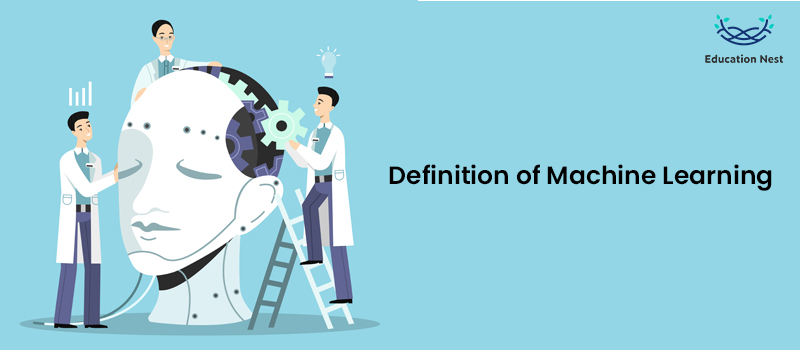
As businesses interact with customers and collect vast amounts of data, they are starting to see the value of machine learning. Data can improve operations and give a company an edge over its competitors.
The Machine Learning Tutorial for Beginners is an excellent resource for learning the basics of machine learning and discovering the practical applications of this powerful technology. Plus, did you know what? This machine-learning tutorial will provide you with the knowledge and practice that will speed up your path to a rewarding career as a Machine Learning Engineer.
Definition of Machine Learning

Machine learning is an important area of research within AI (AI). Like people, ML programs may learn independently from experience (or, more accurately, data) without being explicitly programmed.
- These programmes can adapt and improve themselves in response to new information.
- To simplify, machine learning is the process through which a computer acquires practical knowledge without being explicitly programmed. Instead, they rely on iteratively-learning algorithms to achieve this goal.
- It’s not like machine learning is some fancy new idea. While the concept of automating the use of complicated mathematical computations on massive data has been around for a while, it has only recently begun to acquire traction.
Machine learning is how a machine learns to improve itself by analysing and, if necessary, modifying data. To improve their accuracy and precision, applications “pattern-recognise” data from past calculations and transactions.
Now that we have defined machine learning let’s dive into its inner workings.
You Must Watch: Big Data Testing: A Journey Through the Complex World of Data Verification
How Does Machine Learning Function?
Without a doubt, machine learning is one of the fascinating branches of AI. Data-driven learning is accomplished by providing the machine with well-defined parameters. Learn the inner workings of machine learning to anticipate its future applications better.
- The first step in Machine Learning is to provide the chosen algorithm with training data. Machine learning algorithms need training data, either known or unknown information.
- There is an effect on the algorithm from the training data type, which will be discussed in more depth shortly.
- Incoming data is loaded into it to ensure the algorithm for machine learning is functioning correctly. Then, we compare the forecast to the actual outcome.
- The algorithm is retrained repeatedly till the data scientist achieves the desired result if the forecast and results don’t match.
- This allows the machine learning system to self-teach and provides the best possible response, improving accuracy over time.
What You Need to Know Before Starting The Machine Learning Tutorial
Machine learning is open to anybody interested in a career in IT, but those with a background in college-level statistics and mathematics will have an advantage over the competition.
Machine learning enthusiasts might also benefit from a basic understanding of Python programming. Before diving into the machine learning tutorial, it’s recommended that you finish up some of the introductory courses in data science, such as the machine learning tutorial in Python, Mathematics Refresher, and Statistics Essentials for Data Science.
There are various in-depth learning available, like azure machine learning tutorials,
AWS machine learning tutorial, etc.
What is Included in Machine Learning Tutorial
- The Functioning of Machine Learning: What Is It?
Machine learning is how computers locate and utilise intelligent information without being directed to where to seek it. Machines can also learn on their own by being exposed to new information repeatedly. This happens because apps can use pattern recognition and data mining to learn from past calculations and transactions and give accurate and well-informed results. Inputting training sets into the chosen algorithm is the first step in machine learning.
- Incredible Uses for Machine Learning in the Real World
Machine learning can be used to look at data from people, groups, businesses, and the government to make better predictions about what will happen. It could be used to predict the economics between states and countries and the growth of a company.
- Learning Methods: Supervised and Unsupervised
With supervised learning, the computer is taught by a human. It uses a model that can predict what will happen based on data for which the desired result is already known.
An unsupervised learning system relies on data that hasn’t been tagged to train itself. Intelligent machines and other tech-based devices look for patterns in unlabeled data and respond based on what they find.
- Python Linear Regression
Predicting the future development of a nation’s or state’s economy, GDP, future product prices, home sales, and even game outcomes may all be made using linear regression.
- Applying a Random Forest Algorithm
Random Forest is a way to learn based on making many different “decision trees.” The bulk of the trees selected by the random forest is used to make the final selection.
A few of the applications for random forest algorithms commonly used today in remote sensing include:
- Multi-class object sorting and object identification, such as separating autos and buses in heavy traffic
- Kinect, a feature of modern gaming consoles, uses random forest algorithms to monitor player motion and simulate it in-game.
- A Guide to a Career as a Machine Learning Engineer
To become a Machine Learning Engineer, you must first complete a certification or degree program that covers the technical fundamentals of the field, such as traditional machine learning or reinforcement learning, as well as the more advanced mathematical and statistical principles that are commonly used. Having a firm grasp of these foundational concepts will serve you well in pursuing a career as a machine learning engineer.
Machine learning tutorials are ideal for engineers, data analysts, statisticians, domain specialists, and anyone with a basic understanding of statistics and advanced math, as well as a sense of algorithms.
- Employment Opportunities in Machine Learning
Opportunities in the field of machine learning can be found at both well-established corporations and new ventures. Data science is at the heart of some businesses, and many others have teams whose only job is to work with data.
In addition, businesses that provide application programming interfaces (APIs) and other tools enabling customers to create their algorithms may be good places for machine learning professionals to search for work. As long as big data analysis is necessary, the need for data scientists will remain high.
- Leading Interview Questions and Solutions for Machine Learning
Let’s say you want to talk to a business or employer about a job that involves machine learning. In that case, you should spend a lot of time thinking about the questions they might ask you during an interview to see how knowledgeable you are about the field. You could be asked about specific machine learning techniques, the nature of overfitting, and the steps you can take to prevent it. Questions about the difference between a training set and a test set in a machine learning model are another possibility.
Moreover, this machine-learning tutorial for beginners will serve as a helpful resource.
Machine learning is regarded as one of the most desirable professional paths in the IT sector. People who want to start a career with many opportunities and long-term benefits should consider this topic.
It is a great way to begin a machine-learning tutorial for beginners.

